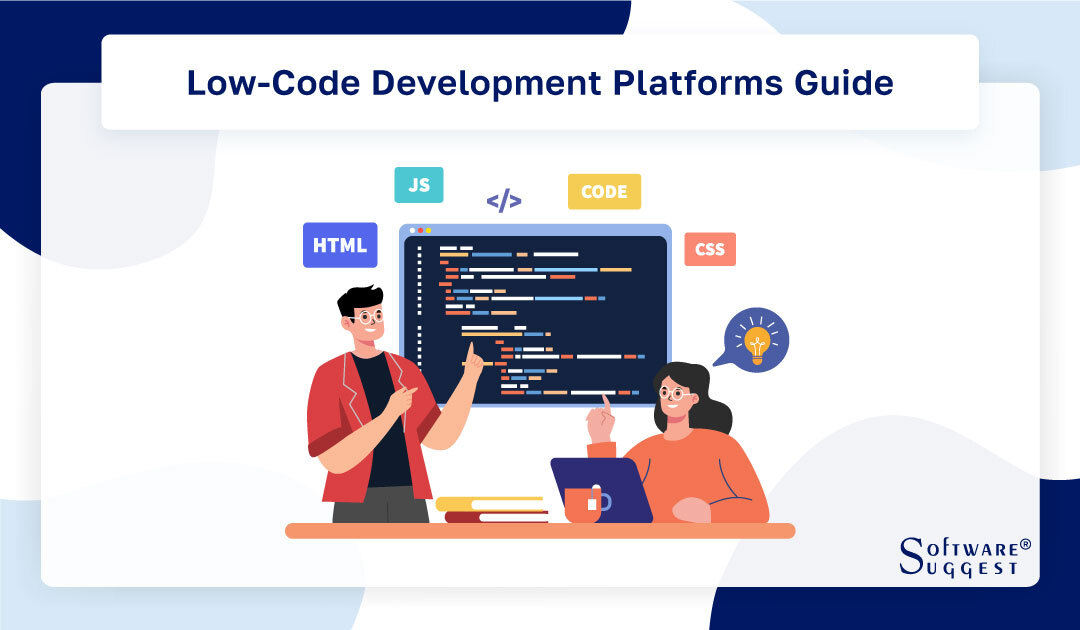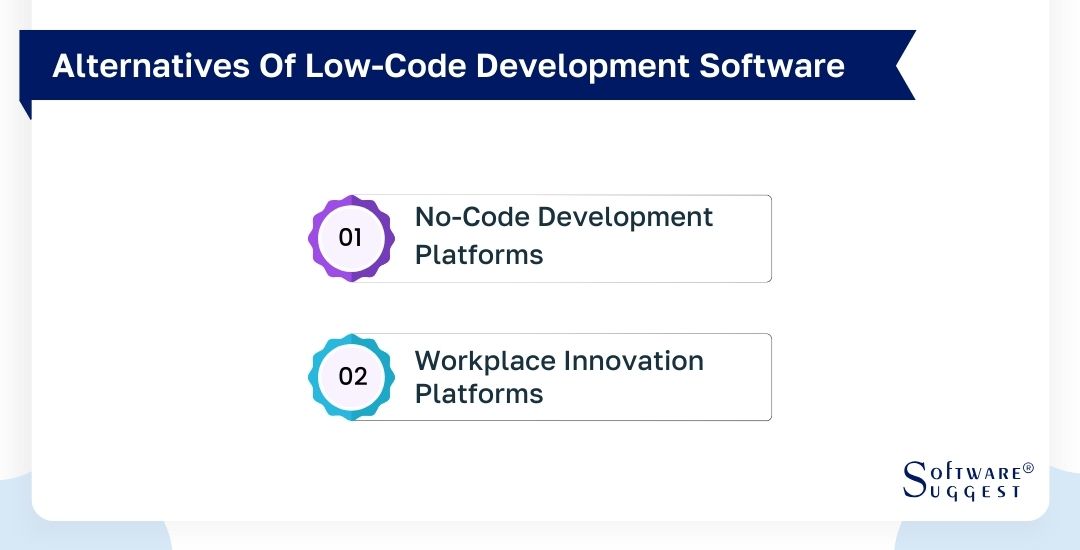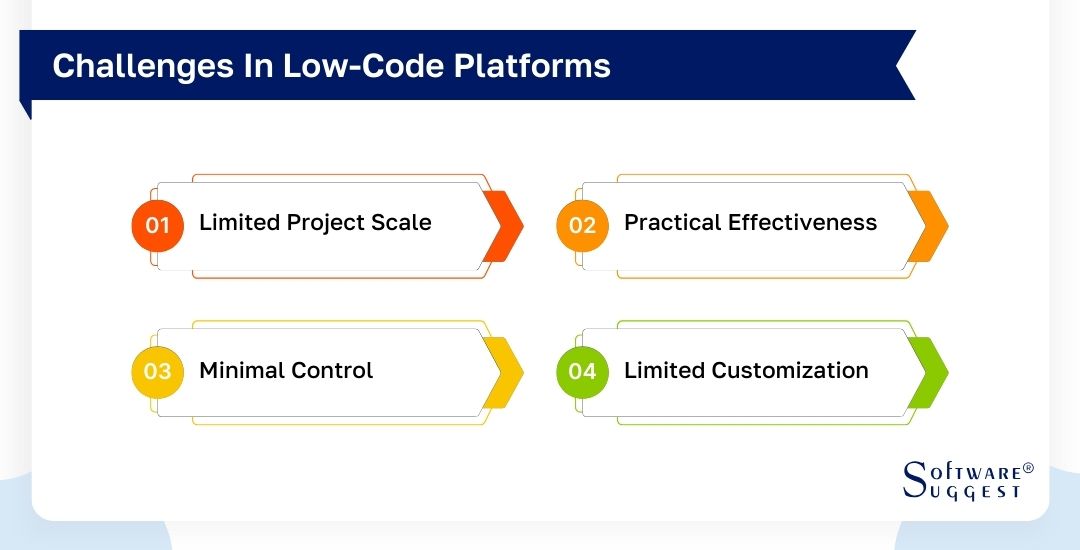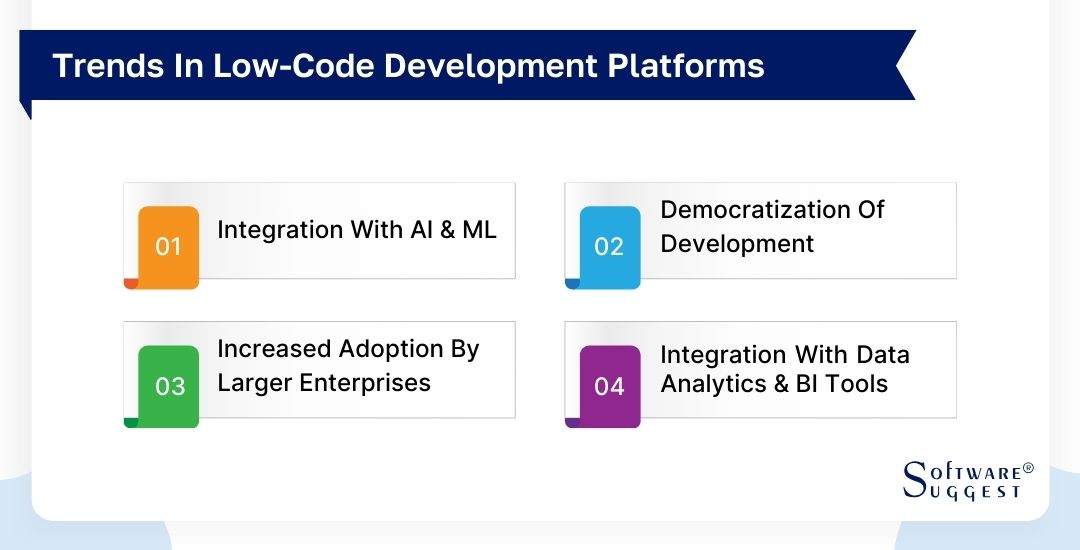Best Low-Code Development Platforms
The best low code development platforms are visual lansa, mendix, OutSystems, Appian, wavemaker, etc. It has a graphical interface for programming that allows for rapid code development while decreasing traditional programming efforts.



No Cost Personal Advisor
List of 20 Best Low Code Development Platform
Contenders | 2024
Development to Deployment DSLC, your scalability p
DSLC is a comprehensive platform for rapid application development on both the front and back end through drag-and-drop functionality with blockchain integration providing secure and scalable growth. Read Cyberium DSLC Reviews
Explore various Cyberium DSLC features, compare the pricing plans, and unlock the potential of seamless operations by selecting the right software for your business.
Features
View all Cyberium DSLC Features- Data Modeling
- Source Control
- Web App Development
- Deployment Management
- Debugging
- Access Controls/Permissions
- Collaboration Tools
- Mobile Development
Pricing
Cyberium DSLC Caters to
- StartUps
- SMBs
- Agencies
- Enterprises
Contenders | 2024
Low Code Software by Bubble Group
Bubble is a fully featured App Design Software designed to serve Startups, Enterprises. Bubble provides end-to-end solutions designed for Windows. This online App Design system offers Change Management, Collaboration, Drag & Drop, Visual Interface at one place. Read Bubble Reviews
Explore various Bubble features, compare the pricing plans, and unlock the potential of seamless operations by selecting the right software for your business.
Features
View all Bubble Features- Design Templates
- Visual Interface
- Reporting/Analytics
- Change Management
- Collaboration
- Feedback Management
- Drag & Drop
- Debugging
Pricing
Bubble Caters to
- StartUps
- SMBs
- Agencies
- Enterprises
Emergents | 2024
A complete cloud infrastructure platform for migra
A next-generation cloud infrastructure platform offering full range of services from migrating, building to running all your IT. It is perfectly designed to run any application, faster and more securely, for less. Learn more about Oracle Cloud Infrastructure
Explore various Oracle Cloud Infrastructure features, compare the pricing plans, and unlock the potential of seamless operations by selecting the right software for your business.
- Data Governance
- Application Development
- Online Analytical Processing (OLAP)
- Data warehousing
- Data Security
- Big Data Analytics
- Analytics
- Data Analysis
Oracle Cloud Infrastructure Caters to
- StartUps
- SMBs
- Agencies
- Enterprises
Contenders | 2024
Platform by Mendix
Mendix is a fully featured low code platform designed to serve Startups, Agencies. Mendix provides end-to-end solutions designed for Web App. This online App Development system offers Code Refactoring, Debugging, Software Development, Mobile Development, Compatibility Testing at one place. Read Mendix Reviews
Explore various Mendix features, compare the pricing plans, and unlock the potential of seamless operations by selecting the right software for your business.
Features
View all Mendix Features- Access Controls/Permissions
- Web App Development
- Deployment Management
- Source Control
- Code-free Development
- Software Development
- Data Modeling
- Reporting/Analytics
Mendix Caters to
- StartUps
- SMBs
- Agencies
- Enterprises
Emergents | 2024
Best Low-Code Development Platform by OutSystems
OutSystems is a one of the best and powerful app development software for making enterprise apps with minimum code.This app creator software has few of the best attributes such as high speed, integrating with everything, full security, scalability, good customer support and much more. Learn more about OutSystems
Explore various OutSystems features, compare the pricing plans, and unlock the potential of seamless operations by selecting the right software for your business.
OutSystems Caters to
- StartUps
- SMBs
- Agencies
- Enterprises
Contenders | 2024
Platform by Appian
This low-code software is used for app designing. It can also be used for task management and integration of email. It provides desktop support for Windows and Macintosh platforms. Read Appian Reviews
Explore various Appian features, compare the pricing plans, and unlock the potential of seamless operations by selecting the right software for your business.
Features
View all Appian Features- Data Mapping
- Process Management
- Process Change Tracking
- Optimize Management
- Process Analysis
- Email Integration
- Task Management
Appian Caters to
- StartUps
- SMBs
- Agencies
- Enterprises
Contenders | 2024
Build Powerful Applications Faster
Zoho low code app development platform is a very simple activity to most complexity and optimization of all business processes with an intuitive interface. They are built on process-based applications, automate routine tasks, and manage data in the process system. Read Zoho Creator Reviews
Explore various Zoho Creator features, compare the pricing plans, and unlock the potential of seamless operations by selecting the right software for your business.
Features
View all Zoho Creator Features- Audit Management
- Barcoding / RFID
- Risk Assessment
- Text Editing
- Customs Clearance
- Driver Settlements
- Application Integration
- GPS tracking
Pricing
Standard
$ 8
User/Month Billed Annually
Professional
$ 20
User/Month Billed Annually
Enterprise
$ 25
User/Month Billed Annually
Zoho Creator Caters to
- StartUps
- SMBs
- Agencies
- Enterprises
Emergents | 2024
Enterprise-Grade Low-code Development Platform
Kissflow Low-Code is a business-friendly low code development platform. Kissflow Low Code comes with a customizable and easy-to-use user interface that allows even non-technical users to create working dashboards, and forms. Learn more about Kissflow Low Code
Explore various Kissflow Low Code features, compare the pricing plans, and unlock the potential of seamless operations by selecting the right software for your business.
Features
View all Kissflow Low Code Features- Analytics
- Code-free Development
- Application Development
- Data Visualization
- Drag & Drop
- App Management
- Code Review
- Dashboard
Pricing
Golden Edition
$ 3000
Per Month
Kissflow Low Code Caters to
- StartUps
- SMBs
- Agencies
- Enterprises
Contenders | 2024
Process-driven CRM for marketing, sales, service.
Creatio is the global supplier of no-code platform for industry workflows automation and CRM. Creatio’s customers enjoy the freedom to own their automation. Freedom is provided through unlimited customization, the ability to build apps without a line of code and a universe of ready-to-use templates and connectors. Read Creatio Reviews
Explore various Creatio features, compare the pricing plans, and unlock the potential of seamless operations by selecting the right software for your business.
Features
View all Creatio Features- Appointment Management
- Document Management
- Call Center Management
- CRM Analytics
- Lead Generation
- Field Sales Management
- Lead Management
- Marketing Collateral
Creatio Caters to
- StartUps
- SMBs
- Agencies
- Enterprises
Emergents | 2024
Platform by GeneXus Consulting
GeneXus is a fully featured App Development Software designed to serve Enterprises, SMEs. GeneXus provides end-to-end solutions designed for Windows. This online App Development system offers Source Control, Mobile Development, Software Development, Deployment Management, Access Controls/Permissions at one place. Learn more about GeneXus
Explore various GeneXus features, compare the pricing plans, and unlock the potential of seamless operations by selecting the right software for your business.
Features
View all GeneXus Features- Collaboration Tools
- Web App Development
- Compatibility Testing
- Source Control
- Deployment Management
- Software Development
- Data Modeling
- Access Controls/Permissions
GeneXus Caters to
- StartUps
- SMBs
- Agencies
- Enterprises
Emergents | 2024
Low Code App Development Platform by Caspio
Caspio is a fully featured App Development Software designed to serve Enterprises, Agencies. Caspio provides end-to-end solutions designed for Windows. This online App Development system offers Compatibility Testing, Physician Management, Deployment Management, Patient Communications, Patient Management at one place. Learn more about Caspio
Explore various Caspio features, compare the pricing plans, and unlock the potential of seamless operations by selecting the right software for your business.
Features
View all Caspio Features- Deployment Management
- Patient Management
- Access Controls/Permissions
- Source Control
- Web App Development
- Physician Management
- Reporting/Analytics
- Data Modeling
Pricing
Free
$ 0
Month
Basic
$ 59
Month
Professional
$ 249
Month
Caspio Caters to
- StartUps
- SMBs
- Agencies
- Enterprises
Emergents | 2024
Platform by Pegasystems Inc
Pega 7 Platform is a fully featured App Development Software designed to serve Agencies, Startups. Pega 7 Platform provides end-to-end solutions designed for Web App. This online App Development system offers Business Rules Management, Collaboration, Process Modeling & Designing at one place. Learn more about Pega 7 App
Explore various Pega 7 App features, compare the pricing plans, and unlock the potential of seamless operations by selecting the right software for your business.
Features
View all Pega 7 App Features- Business Rules Management
- Dashboard
- Software Management
- Contact Management
- Process Modeling & Designing
- Collaboration
- Import/Export Management
- Collaboration Tools
Pega 7 App Caters to
- StartUps
- SMBs
- Agencies
- Enterprises
Contenders | 2024
Platform by Airtable
Airtable is the solution for CRM to manage all-in-one with powerful features. It suits for such business like entertained, restaurant and hotels. It is very accurate and flexible software that delete all the duplication itself and integration with social media for secure communication. Read Airtable Reviews
Explore various Airtable features, compare the pricing plans, and unlock the potential of seamless operations by selecting the right software for your business.
Features
View all Airtable Features- Appointment Management
- Invoice
- Accounting
- Team Management
- CRM & Sales Dashboards
- Workflow Management
- Opportunity Management
- Access Monitoring
Pricing
Free
$ 0
User/Month
Plus
$ 10
User/Month
Pro
$ 20
User/Month
Airtable Caters to
- StartUps
- SMBs
- Agencies
- Enterprises
Contenders | 2024
Low-Code Development Platform by LANSA Inc
Visual LANSA is a fully featured low code development platform designed to serve Enterprises, Agencies. Visual LANSA provides end-to-end solutions designed for Macintosh. This online App Development system offers Reporting/Analytics, Source Control, Deployment Management, Code Refactoring, Debugging at one place. Read Visual LANSA Reviews
Explore various Visual LANSA features, compare the pricing plans, and unlock the potential of seamless operations by selecting the right software for your business.
Features
View all Visual LANSA Features- Mobile Development
- Debugging
- Access Controls/Permissions
- Collaboration Tools
- Web App Development
- Source Control
- Deployment Management
- Data Modeling
Visual LANSA Caters to
- StartUps
- SMBs
- Agencies
- Enterprises
Emergents | 2024
User Management for the PLG Era
Frontegg is an Low Code Development Platform, that enables self-service, security and enterprise capabilities through a rich user management interface. Learn more about Frontegg
Explore various Frontegg features, compare the pricing plans, and unlock the potential of seamless operations by selecting the right software for your business.
Features
View all Frontegg Features- Software Management
- Dashboard
- Access Request Management
- Access control
- Analytics
- Billing & Invoicing
- Pre-built Templates
- Credential Management
Pricing
Starter
$ 0
Free forever for up to 5 Organizations
Scale
$ 250
Includes 25 Organizations
Frontegg Caters to
- StartUps
- SMBs
- Agencies
- Enterprises
Emergents | 2024
Platform by Hyland Software Inc
OnBase is a certify enterprise content management solution for each level of government helping each meet today’s difficulty of smaller budgets and workers during laying the reason for simplified, effective and mobile government information technology. Read OnBase Reviews
Explore various OnBase features, compare the pricing plans, and unlock the potential of seamless operations by selecting the right software for your business.
OnBase Caters to
- StartUps
- SMBs
- Agencies
- Enterprises
Emergents | 2024
Platform by Nintex
Nintex is a fully featured Document Management Software designed to serve Startups, SMEs. Nintex provides end-to-end solutions designed for Windows. This online Document Management system offers Compliance Management, Automated Routing, Document Indexing, Electronic Signature, Full Text Search at one place. Learn more about Nintex
Explore various Nintex features, compare the pricing plans, and unlock the potential of seamless operations by selecting the right software for your business.
Features
View all Nintex Features- Collaboration Tools
- Electronic Signature
- Specialty Contracts
- Text Editing
- Collaboration
- File Recovery
- Optical Character Recognition
- Data Verification
Pricing
Standard Edition
$ 650
Per Month
Enterprise Edition
$ 950
Per Month
Nintex Caters to
- StartUps
- SMBs
- Agencies
- Enterprises
Emergents | 2024
Fast visual internal tools builder
UI Bakery is an internal tools builder allowing you to build a UI via 25+ ready-made components, connect your database or other data sources (APIs, business apps), and deploy a complete app in a click. Invite users to collaborate, manage their roles and permissions. Learn more about UI Bakery
Explore various UI Bakery features, compare the pricing plans, and unlock the potential of seamless operations by selecting the right software for your business.
Features
View all UI Bakery Features- Visual Interface
- Time & Expense Tracking
- Process Mapping
- Process/Workflow Automation
- Dashboard Creation
- Access control
- User Activity Monitoring
- Approval Workflow
UI Bakery Caters to
- StartUps
- SMBs
- Agencies
- Enterprises
Emergents | 2024
Platform by Retool
Retool is a fully featured App Design Software designed to serve Enterprises, SMEs and StartUps. Retool provides end-to-end solutions designed for Web App and Android. This online App Design system offers Drag & Drop at one place. Learn more about Retool
Explore various Retool features, compare the pricing plans, and unlock the potential of seamless operations by selecting the right software for your business.
Features
View all Retool Features- Drag & Drop
Retool Caters to
- StartUps
- SMBs
- Agencies
- Enterprises
Category Champions | 2024
Work Smart. Achieve More.
Quixy is a power-packed digital transformation platform helping enterprises enhance efficiency, transparency, and productivity of business operations by empowering business users with no coding skills to automate workflows and processe. Read Quixy Reviews
Explore various Quixy features, compare the pricing plans, and unlock the potential of seamless operations by selecting the right software for your business.
Features
View all Quixy Features- Quality Management
- Text Editing
- Process Mapping
- Application Integration
- Rules-Based Workflow
- Data Visualization
- Work Hour Tracking
- Multi-Department/Project
Pricing
Platform
$ 20
Per User/Month, Billed Annually. Starts with minimum 20 users
Solution
$ 0
Contact Quixy Sales
Enterprise
$ 0
Contact Quixy Sales
Quixy Caters to
- StartUps
- SMBs
- Agencies
- Enterprises

In an era where speed, efficiency, and innovation are paramount, low code platforms have emerged as a game-changer, enabling businesses to create applications swiftly with minimal coding expertise. Investing in a low-code platform can give organizations a competitive advantage and streamline workflow automation.
This detailed guide is your compass across the complex environment of low-code development, whether you're an IT professional, a business leader, or a developer. As a result, you will be able to make educated decisions and embark on a digital transformation journey. So, let’s dive in
What are Low-Code Development Platforms?
Low-code development platforms allow businesses to create custom solutions and applications without writing code. You can use low-code development platforms to build various applications, from simple Customer relationship management (CRM) systems to complex Enterprise Resource Planners (ERPs). Low-code and no-code platforms are similar to low-code software development platforms but are easier to use. It also allows for the creation of more complex applications.
Low-code software development platforms have recently seen a surge in usage. They offer companies a way to create custom web application development with little to no code. These platforms also help people who need time and resources to code.
The Rise of Low-Code Platforms: Which Ones to Start Using
As technology rapidly shifts, businesses are finding that they must adapt at a faster pace to remain competitive. That has led to the rise of low-code development platforms, allowing companies to create custom apps and solutions without writing code.
Over seventy percent of new apps developed by organizations will utilize low-code and no-code technologies by 2025, according to Gartner. This means the development of more than two-thirds of all new business applications will use low-code development platforms. This shift is still in its infancy, but businesses must begin investigating these platforms to stay ahead of the curve.
Read on and find out how these innovations are shaping the future.
How Do Low-Code Development Platforms Work?
Low-code development platforms enable businesses and developers to collaborate on building enterprise applications without traditional coding. Low-code development platforms allow business users to create and configure their applications by dragging and dropping pre-built components. These platforms enable businesses and users to create applications by assembling predefined code blocks.
The features allow companies to use a visual interface to develop custom applications without learning traditional coding languages. Low-code development platforms typically use a graphical programming language, while low-code software development platforms usually use a visual block editor.
These platforms have become easy to use in recent years, leading to more businesses adopting their use for their purposes. Companies want to quickly develop custom applications without requiring expensive developer resources.
Who are the Users of Low-Code Platforms?
Low-code development platforms are excellent for people looking to simplify the process of developing applications. But who are the primary users of these platforms?
These platforms cater to non-technical business people who want to create simple applications without learning to code. These people may be business owners, managers, or employees who need to quickly create simple solutions to help them do their jobs better.
However, some technical users may find low-code platforms useful. For example, developers may use these platforms to quickly create prototypes or POCs without spending significant resources. They may use these platforms to develop simple applications they can hand off to a non-technical user for further development.
What are the Types of Low-Code Software?
The best low-code software comes in various types, each tailored to specific use cases and development needs. In this comprehensive overview, we'll explore three primary types of low code software. Let's see in detail:

-
For business applications: The best low code platforms designed for building business applications are geared toward addressing the unique requirements of establishments. The low code app development platform allows developers to create complex, data-centric applications with minimal manual coding. They often offer pre-built templates and integrations for common business functions.
-
For process creation and management: Workflow automation and optimization are the main focus of low-code companies that are designed for process creation and administration. Users are able to plan, automate, and keep an eye on business processes at these facilities. Consequently, tasks and data are guaranteed to move through an establishment smoothly.
-
For user-facing applications and websites: The best low code software for this purpose excels at building websites and applications that interact with customers. The purpose of these low code development companies is to offer users an enjoyable and frictionless experience. Usually, they offer a range of templates and design tools to enable customers to swiftly create web and mobile applications.
What are the Benefits of Best Low-Code Development Platforms?
Low code development platform offers a wide array of benefits that make them increasingly popular for organizations of all sizes. Here, we explore the benefits of low code application development.

-
More time to grow the business
With low-code development platforms, businesses can get their applications up and running much faster than coding them from scratch. That can be a big help in today's fast-paced business world. These platforms allow businesses to focus more on the business side rather than on development—which takes a lot of time.
-
Increased efficiency and productivity
Businesses can drastically reduce the time required to build custom applications using a low-code development software. That can lead to increased efficiency and productivity within the organization. Building templates of code speeds up the process compared to manually coding everything.
-
Greater flexibility
With low-code development platforms, businesses have greater flexibility in terms of what they can create. They aren't limited by what is possible with pre-made templates or frameworks. These technologies allow for greater creativity and innovation.
These are just a few benefits businesses can experience when using these platforms. Overall, these tools offer an excellent way for businesses to quickly and easily create custom applications. -
Improves development speed
Low code development platform is renowned for its ability to expedite the application development process. This is accomplished by drastically lowering the amount of manual coding necessary. With visual interfaces and pre-built components, developers can assemble applications faster. Thus resulting in a shorter time-to-market. This rapid development pace allows establishments to respond quickly to changing market demands.
Additionally, it supports gaining a competitive edge and allows for greater adaptability to changing client needs. The efficiency and user-friendliness of low code app development software make it accessible to a wider range of specialists. As a result, application development is expedited, pushing the boundaries beyond those typically confined to traditional developers.
-
Enhances customer experience
In an era where the customer experience reigns supreme, low code development tools play a pivotal role. By expediting the creation of user-facing applications and websites, establishments can offer enhanced digital experiences to their customers. These enterprise platforms facilitate the development of responsive, user-friendly interfaces with visually appealing designs.
They make it possible to incorporate customer engagement software like chatbots and interactive forms, giving users smooth interactions. Establishments may promote customer happiness, drive greater user engagement, and cultivate loyalty by enhancing the customer experience.
-
Reduced costs
Hiring experienced software developers can cost a lot of money. Seasoned ones charge about $109,020/year for their services. With minimal help from software developers, businesses can reduce their overhead expenses.
What are the Features of the Best Low-Code Software?
Low-code development establishments have gained prominence in the software development landscape due to their ability to streamline application development. These low code tools make it easier to use for a wider range of users. Let's see the key features in detail:

-
Code extensibility
One of the hallmark features of the best low-code platforms is their support for code extensibility. While low-code business users emphasize minimal coding, there are scenarios where custom code may be required for specific functionalities or integrations. The top platforms allow developers to seamlessly integrate custom code into their applications.
As a result, flexibility to suit particular business requirements is provided. This ability to blend low code and traditional coding ensures that complex applications can be developed without limitations. Thus making these establishments suitable to use low code for a wide range of projects.
-
Visual modeling
Visual modeling is at the core of low-code development. These systems offer simple drag-and-drop interfaces as well as visual programming software. It enables users to create applications by simply arranging pre-built components and defining their behavior visually. This makes it unnecessary to do a lot of hand coding and allows more people to get involved in the creation of applications.
It includes business analysts and subject matter experts. Visual modeling accelerates the development process, fosters collaboration, and reduces the learning curve for newcomers to the platform.
-
No-code development
The best low-code platforms go beyond supporting professional developers. They also cater to non-technical users through no-code development capabilities. No-code tools allow individuals with no programming background to create functional applications. These establishments offer pre-built templates and components for common use cases.
Thus enabling users to design, deploy, and iterate on applications independently. This democratization of app development empowers various departments within an organization to automate processes. Hence reducing dependency on IT departments and accelerating time-to-market.
-
Workflow templates
Effective business process automation is a key feature in many low-code platforms. Workflow templates provide pre-designed, customizable, and easy-to-use templates for common business processes. For example, approval workflows, document routing, and customer onboarding.
These templates make it easier to create automated processes, which ensures consistency and saves time. By altering these templates to meet their own needs, users can streamline corporate processes and lower error rates.
-
Application lifecycle management
Software development necessitates application lifecycle management (ALM), which top platforms understand. ALM features in this platform encompass version control, testing, deployment, and monitoring. Development teams may oversee an application's whole lifespan with the help of these business apps.
It includes everything from development and testing to deployment and testing. They make it easier for team members to work together. Also, guarantees that programs will move smoothly from development to production settings.
-
Drag-and-drop interfaces
Drag and drop interfaces are a cornerstone of these platforms. These third-party visual design tools enable users to build and modify application components by simply dragging and dropping them onto the canvas. This systematic technique streamlines the development process and lessens the requirement for in-depth coding knowledge.
Users can create user interfaces, define data models, and establish logic flows with ease. Drag-and-drop interfaces enhance productivity and make application development accessible to individuals with varying technical skill levels.
Difference Between No-Code and Low-Code Platforms
- No-code development platforms are great for quickly building prototypes or proof-of-concept (POC) applications with little to no assistance from a developer.
- Low-code development platforms require some developer involvement but offer many more features and best suit production applications.
- No-code development platforms have limited functionality and flexibility than low-code platforms.
- Low-code development platforms offer a visual drag-and-drop interface for building applications, making them easier for those with less technical expertise. When deciding which platform to use, it is imperative to consider the needs of the application and the skills of the team building it.
- No-code platforms are best for simple applications with no customization requirements.
- Low-code platforms are an excellent choice for more complex applications that require customization or integration with other systems. Low-code software development platforms today are almost at par with traditional development methods regarding their features and functionalities.
Read Our Detailed Article: Low-Code vs. No-Code: Definition & Differences
Things to Consider Before Choosing a Low-Code Development Platform
Low-code development platforms are becoming a trend as they allow for rapid application development without requiring extensive coding knowledge. They are an excellent option for businesses that need to create and deploy applications quickly. They are also great for those who lack the resources to hire a dedicated development team.
There are several low-code development platforms available, so it can take time to decide which is right for you. Here are a few factors to consider:

-
Type of application
Some low-code development platforms work better for specific types of applications. For example, you need to build a complex CRM system. You'll want to choose a provider with specific features tailored for that purpose.
Providers offering a platform explicitly for CRMs must have templates with all the necessary components to run a fully functioning CRM. Using these templates ensures functionality and helps with your delivery date. -
Experienced with coding
If you're new to coding, you'll want to choose an easy-to-use platform that doesn't require extensive coding knowledge.
Conversely, if you have a team of experienced developers, select a provider that offers more flexibility and control. Knowing the caliber of your team before choosing a platform can help you determine which provider to subscribe to. -
Customization
If you need complete control of the look and feel of your applications, choose a platform that offers customization options. These platforms are more for rapid application development and may provide less flexibility.
Before choosing a platform, carefully consider what amount of customization your project requires. Doing so ensures lesser headaches and avoids compatibility issues in the future. -
Budget
Most low-code development platforms come with a price tag, so it's crucial to consider how much you're willing to spend. Some platforms are more affordable than others but with fewer features. So it's worth shopping around before deciding. Staying within budget reduces overhead expenses so you can focus more resources on other aspects of the business.
-
Scaling
If you plan on using low-code development platforms for the long term, choose one that can scale with your business. You want to avoid being stuck with an application that does not allow growth during a critical time in your business. Many of these platforms can handle large volumes of traffic. However, ensuring your chosen platform can meet your needs as your business grows is essential.
Additionally, it's important to remember that not all low-code and no-code platforms are the same. Some platforms offer more features and flexibility than others. It is important to research before making a decision. -
Easy to use
Most low-code development platforms are designed for users with little or no coding experience. More so, rookies and experienced developers can find these platforms easy to use, thanks to their user-friendly interfaces and drag-and-drop tools.
Low-code platforms are also generally very flexible, which allows users to create applications that meet their specific needs. However, this flexibility can also be a drawback, requiring more time and effort to customize applications than traditional coding methods. -
Reputation of the vendor
When choosing a low-code development platform, it's essential to consider the provider's reputation. Some platforms have a better reputation than others for their usability and features. Check if they have a good track record. Know if their after-sales support is acceptable to you. While you should select a reliable one, it doesn't hurt to know if they have excellent customer service.
Which Companies Offer Low-Code Development Platforms, and How Much Do They Cost?
Low-code software development platforms are becoming popular alternatives to traditional software development methods. That is because they offer a faster, easier way to create software. You can drag and drop components to build your application, and the platform will take care of the rest. That makes it possible for non-techy users to create software, speeding up the development process.
Several companies offer low-code development platforms. These platforms usually cost between $50 and $2,000 per month, depending on the features and capabilities you need.
Some of these companies include
What are the Alternatives to Low-Code Development Software?
While low-code development establishments offer significant advantages in simplifying software development, there are alternative approaches to consider. It depends on specific needs and preferences. Two prominent alternatives to low-code development software are no-code development platforms and workplace innovation platforms. Let's see each in detail:

-
No-code development platforms
No-code development platforms are closely related to low-code platforms but take simplicity to the next level. They are made to enable anybody to construct applications with little to no coding skills. No-code platforms offer ready-made, easily navigable templates and components that may be tailored to match certain business needs.
These software establishments are particularly well-suited for organizations looking to democratize application development across various departments. Thus allowing non-technical users to build and modify applications independently. No-code platforms are ideal for businesses seeking rapid development without extensive reliance on IT departments.
-
Workplace innovation platforms
Workplace innovation platforms cover a broader spectrum of tools and technologies, all aimed at enhancing corporate operations and encouraging creativity. These platforms establish a comprehensive environment that eases the creation, control, and automation of numerous business functions and workflows. They typically offer capabilities such as document management, business process modeling, analytical tools, and collaboration features.
Workplace innovation platforms offer flexibility in addressing complex, enterprise-level challenges. Thus making them an attractive choice for establishments looking to optimize their entire work environment. While they may require more configuration and customization, they provide a comprehensive solution for enhancing productivity and efficiency.
What are the Challenges Faced in Low-Code Platforms?
While low-code platforms offer accelerated application development, they present challenges. A wise selection of low-code solutions requires awareness of these constraints. We explore four key challenges in low-code software.

-
Limited project scale
Scalability of projects is a significant difficulty in low-code development. While low-code solutions excel in rapidly developing small to medium-sized applications, they may fall short of the requirements of larger projects. Low-code establishments' inherent automation and simplicity may have limits.
This is particularly valid in situations involving sizable databases, complex integrations, and substantial data processing. Organizations undertaking large-scale software development projects should assess whether a low-code platform can adequately handle the project's scope and intricacy.
-
Practical effectiveness
The practical effectiveness of platforms can be a challenge, particularly when it comes to creating applications with intricate and specialized functionalities. While these platforms excel at streamlining common development tasks, they may not be the best fit for projects that demand a high degree of customization or unique features.
In such cases, organizations may find that the initial speed of development provided by low-code tools is offset by the need for extensive custom coding, which can be a counterproductive trade-off.
-
Minimal control
These platforms aim to simplify development by abstracting the underlying code, which can limit the developer's control over the application's architecture. While this can be an advantage for rapid development, it can also be a challenge when establishments need precise control over every aspect of their applications.
-
Limited customization
The platform offers pre-built components and templates to enable rapid and simple development. But occasionally, this simplicity of usage might lead to fewer customizing choices. Organizations that require highly customized applications may find that low-code platforms do not offer the flexibility needed to meet their unique requirements.
Market Trends in Low-Code Development Platforms
Low-code development platforms have evolved in response to the growing need for faster, more accessible software development companies. The future of this industry is bright, with projections reaching an impressive $36.43 billion by 2027. In this exploration, we delve into four significant market trends.

-
Integration with AI & ML
In the market for low-code development platforms, the advent of artificial intelligence (AI) and machine learning (ML) technologies is a notable trend. This connection expands the potential of low code establishments by allowing developers to use AI and ML models for data analysis, prediction, and automation.
The platform now comes with pre-built AI and ML components, making it easier to create intelligent applications. This trend holds particular significance in industries like finance, healthcare, and e-commerce, where predictive analytics and automation can greatly improve factors. These include operational efficiency, customer experiences, and decision-making processes.
-
Democratization of development
Development democratization is an important trend in the low-code market, stressing accessibility and equality. The platforms are intended to allow a broader range of users to participate in the application development process. It includes business analysts and non-technical professionals.
The visual, user-friendly interfaces and pre-built components enable these people to freely design and change apps, decreasing dependency on traditional developers. This concept promotes organizational creativity, agility, and collaboration by removing boundaries between IT and business divisions.
-
Increased adoption by larger enterprises
While low-code platforms initially gained popularity among small to mid-sized businesses, a significant market trend is the increased adoption by larger enterprises. These businesses are seeing how quickly digital transformation projects can be advanced by using this platform.
It also minimizes development costs while meeting the increased need for corporate applications. Modern platforms' scalability and adaptability make them viable alternatives for large companies. As a result, they may streamline processes, improve client experiences, and remain competitive in volatile marketplaces.
-
Integration with data analytics and BI tools
Business intelligence (BI) and data analytics tool integration is becoming more and more common in low code platforms. This trend allows establishments to harness the power of data by seamlessly connecting their applications to analytics platforms. Thus enabling data-driven decision-making and real-time insights.
By integrating data analytics and BI capabilities into platforms, establishments can create applications that not only capture and process data but also provide meaningful visualizations and reporting. Thus enhancing their ability to extract value from their data assets.
What are Some Best Practices for Effectively Using a Low-Code Platform?
When using a low-code platform to create custom web applications, follow some best practices to maximize your results. Here are a few tips to get you started:
-
Start small
Wait to try to build a complex application. Start with a small project and work your way up.
-
Use the platform's features
Take advantage of the platform's features and capabilities to make building applications more accessible.
-
Get help if you need it
There are plenty of resources, such as tutorials and documentation, to help you get started. If you get stuck, don't be afraid to ask for help.
-
Test your application thoroughly
Make sure your application works as expected before deploying it to users.
-
Iterate and improve over time
Use feedback from users to improve your applications over time.
Conclusion
In conclusion, this buyer guide has provided a comprehensive overview of the best low-code development platforms. Thus ensuring that buyers are well-informed before making their purchase. This guide gives helpful ideas for both experienced developers and businesses trying to optimize their app development process. Hence, you can confidently reckon on this guide every time you make a low code development platform purchase.
Related Articles:
FAQs
With more and more low-code and no-code tools becoming available, it's becoming easier and more accessible for people to create software without any coding experience. While these tools have their benefits, there are some situations where manual coding is still necessary.
Manual coding is necessary when you need to have complete control over the code that's being used. With low-code and no-code tools, you're often limited to the options available within the platform. If you need to make a custom change or addition, you'll need to do it manually. Low-code and no-code tools are a great way to build simple applications quickly. However, there are still some situations where manual coding is necessary.Low-code development is ideally suited for simple applications that don't require a lot of customization or debugging. In contrast, manual coding is often a better option if you need to make a lot of changes to the code or track down where an issue is occurring.
Low-code development platforms can be an excellent way even for seasoned developers to build applications. That's because these platforms provide speed thanks to their automation process.
Low-code development platforms can be an excellent way to speed up the application development process. They allow you to focus on creating the functionality of your application rather than worrying about the code itself.
Most low-code and no-code development platforms offer many resources to help you get started, including tutorials and documentation. Check their website and see what they have to offer. In addition, most platforms have a support team that can answer any questions you may have.
Explore several user forums where you can ask questions and get feedback from other users. Another way is to check product reviews of the platform to check how other users find them useful.
Yes, you can create mobile applications using low-code software development platforms. Many platforms offer built-in support for creating mobile apps, making building applications optimized for mobile devices easier.
Low-code development platforms have recently seen a rapid increase in popularity as businesses seek to adapt to the current demands. They offer companies a way to create custom applications with the least time and cost quickly. That can be a considerable sleight-of-hand for businesses that want to stay competitive but need more time or resources to burn.






















